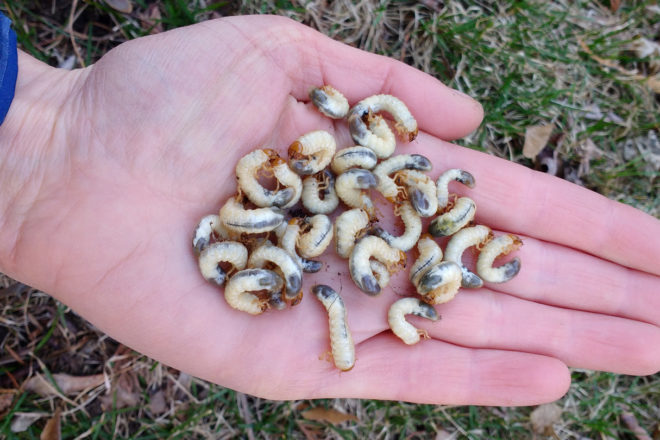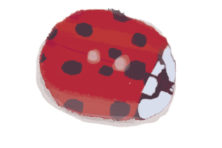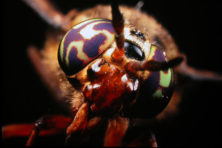Don’t Let This Grub Bug You
- Share
- Tweet
- Pin
- Share

If you’ve driven anywhere around Sturgeon Bay the last couple weeks, you might have noticed significant damage to grassy areas. The grass may be completely torn up, have areas with some digging, or have large bare patches. Perhaps this describes your yard.
What is it and why have I never seen this before?
The damage is due to grubs (the immature stage) of the European chafer beetle. This is a new problem and it began last year.
European chafer is an invasive species first found in the U.S. in 1940, but the first time it was found in Wisconsin was last summer in Door County. According to UW Entomology specialists, we still have the only report of it in the state.
European chafer grubs feed on grass roots, which results in dead patches of grass. The areas that are torn up are due to birds, skunks or other animals searching for and feeding on the grubs. And just because your yard may be torn up and your neighbor’s yard looks fine, does not necessarily mean they aren’t there. This insect could be present in varying numbers in grass throughout Sturgeon Bay and the surrounding region.
Keep in mind that other things can damage grass, including salt from the winter, waterlogging, areas with too much shade, nutrient deficiency, disease, etc. Before moving forward with any type of treatment, check to make sure it is grub damage: pull back the grass at the edge of a dead or dug-out patch in about a one-foot square. Shake the clump of grass to free any grub that may be feeding in the root zone. Dig about two inches down into the soil and look for grubs there as well. Repeat this process about five times in other areas in the lawn. At this time of year, the grubs are mostly white, C-shaped, and about the size of a dime. Five to 10 grubs in a one-square-foot area are enough to cause noticeable damage.
What can I do about it right now?

European chafer grubs dug up April 6, 2017, from a yard near Sturgeon Bay. Photo by Annie Deutsch.
Unfortunately there isn’t much to do about it right now, but things should start to look better in the next couple months. Immature insects go through different growth stages, and right now the European chafer grubs are fully mature. They are the largest that they will get, they are eating the most, and they are the least susceptible to insecticides. Additionally, the mature grubs spend the winter deeper in the soil and as temperatures warm, they move back up into the root zone of the grass and begin to feed. That means right now the grubs are at varying levels throughout the soil, so an insecticide application is not recommended because it will likely miss many of them and have inconsistent results.
Because the grubs are fully mature, they are going to feed until around May, descend into the soil to pupate (transform), and then emerge as adult beetles. From the time they pupate, are adults, and the next generation are eggs, they don’t feed so the grass can begin to recover.
The best thing to do now is to press down any patches of grass that have been dug out and wait. Once temperatures are warmer in the next couple weeks, you can spread grass seed to start to fill in bare patches.
What can I do in the long run?
While there isn’t much to do about European chafer right now, insecticides are the main way to deal with the grubs. These products should be applied to the grass mid-summer. Not all insecticides will work, and even effective insecticides will not work well when used at the wrong time. A list of the most effective products are available in a publication posted on our website, door.uwex.edu/horticulture, or we have copies available at the UW-Extension office. Alternative-type products including nematodes have not been shown to be reliable. Also, milky spore only attacks Japanese beetle grubs, so it will not work against European chafer.
Overapplying insecticides or using homemade concoctions may have detrimental effects to the grass or other organisms in/around your yard, so be careful and make sure to follow all label instructions whenever using any insecticide or related product.
Throughout the summer, good lawn care can help the grass grow well and tolerate more damage. Watering the grass, applying fertilizer and cutting it at a longer height can all help. Beware: too much fertilizer may cause the grass to grow more leaves but less roots, meaning grub feeding will kill the grass more quickly. Therefore, make sure to follow all label recommendations for fertilizer use and remember that more is not necessarily better.
Even with the correct insecticide and excellent lawn care, the European chafer is very hard to control. Since this is only the second year that European chafer has been present in Wisconsin, we have yet to see what are the long-term effects of this insect in our area.
If you would like more information, visit door.uwex.edu or call the UW-Extension office at 920.746.2260.



